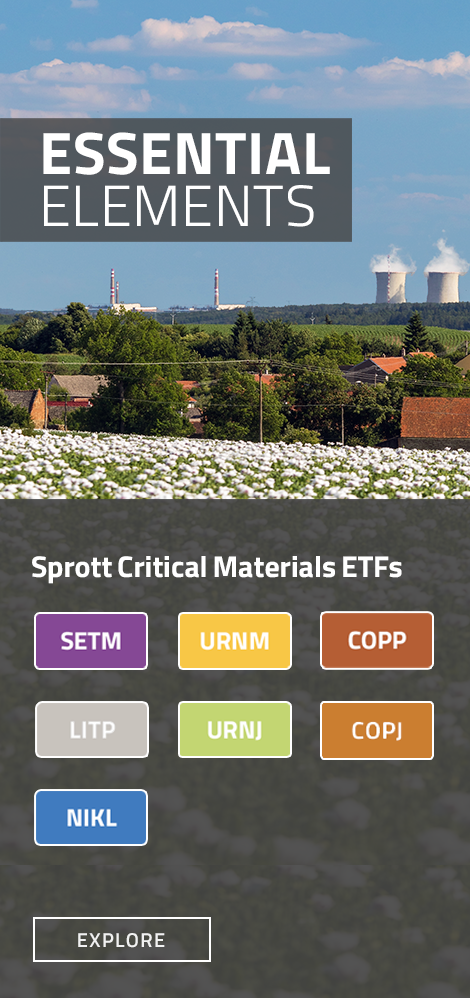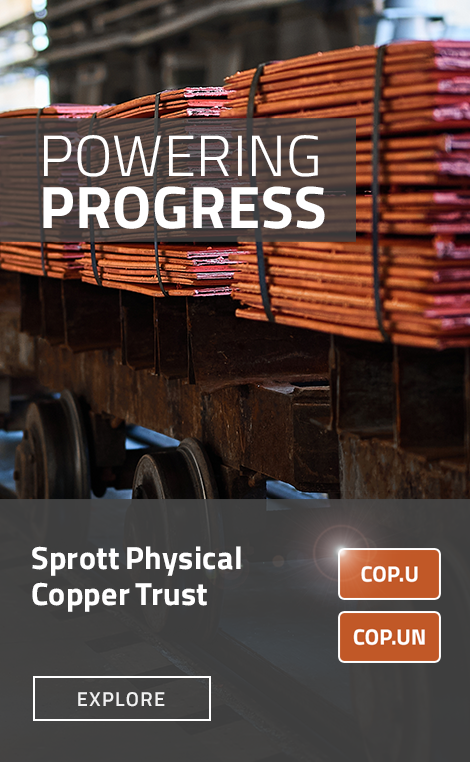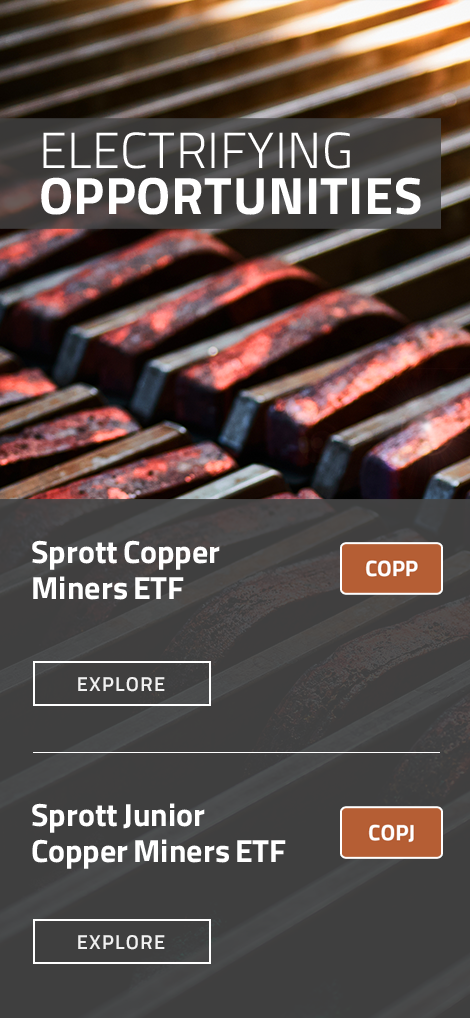August 26, 2024 | 11 mins 06 secs
Author and acclaimed Reuters journalist Ernest Scheyder discusses his book, The War Below: Lithium, Copper, and the Global Battle to Power Our Lives, with Sprott's Steve Schoffstall in this exclusive interview.
For the latest standardized performance of the Sprott Energy Transition ETFs, please visit the individual website pages: SETM, LITP, URNM, URNJ, COPP, COPJ and NIKL. Past performance is no guarantee of future results.
Video Transcript
Steven Schoffstall: Welcome to Shifting Energy. I'm Steve Schoffstall, Sprott Asset Management. It's great to have you watching. We're very excited to be joined by special guest Ernest Scheyder on today's show. Ernest is a senior correspondent at Reuters, covering the clean energy transition in critical minerals. His latest book is titled The War Below: Lithium, Copper, and the Global Battle to Power our Lives, and is an editor's pick for best book of the year so far in 2024 on Amazon. Ernest, we're glad to have you joining us. Welcome to the show.
Ernest Scheyder: It's great to be with you, Steve.
Steven Schoffstall: In The War Below, you focus on five critical materials. Could you tell us briefly about these metals and why they're critical to the transition to cleaner energy?
Ernest Scheyder: Certainly. The book looks at a category of roughly five critical minerals. Those are lithium, copper, cobalt, nickel, and rare earths. Right off the bat, I want to say that many critical minerals have broad uses across our global economy. When I was telling this story, I wanted to pick those five because they tend to be the most widely used, especially in our global electrification transition.
Lithium, of course, is the anchor of the lithium-ion battery. It's the lightest metal on the periodic table of elements and is very good at retaining a charge, making it the perfect metal for batteries.
Copper, of course, is used in wiring, a host of electronics and motors, the lights in your ceiling, and the microphones with which we're talking to each other right now. It is nearly ubiquitous in many electronic devices, so it was important to include that.
Nickel and cobalt can have various uses in batteries, depending on the chemistry design of a battery. Cobalt can help reduce what's known as thermal runaway or the spontaneous combustion of a lithium-ion battery, which I should say is very rare, but cobalt can make it even rarer. Nickel can help extend the range of a lithium-ion battery. Rare earths are a grouping of roughly 17 minor metals on the periodic table of elements that are not as rare as their name implies. The good analogy I like to give is they're like the pepper to a steak.
You wouldn't use a lot of them. You'd use small amounts, but they can have a huge impact when used in the right area. A good consumer example is the device that makes your cell phone vibrate. It is made from a magnet made with rare earths. There are no known substitutes yet, so you can see how these are used across the global economy. They're also, of course, used in electric vehicles. The thing that turns power into motion in an electric vehicle is a magnet made from rare earths.
For The War Below, I wanted to examine these broad classifications—not to say that the list is exhaustive, but to introduce the reader to these five main groupings and explore where, how, and why they're produced, not only in the U.S. but worldwide.
Steven Schoffstall: Thanks for that explanation. China has been a leader in producing many of these critical materials over the last several decades. How is this impacting the market, and what are the U.S. and Western governments doing to help level that playing field?
Ernest Scheyder: One of the tension points I explore in The War Below is how the U.S. helped start or build up many of these modern critical mineral supply chains in the 20th century. Certainly, with rare earths in the years after World War II, the U.S. invested a lot in the science and the know-how to be able to prop up that industry. The interest began to wane in the latter part of the 20th century in the U.S. and many Western countries, just as interest began to rise in China. Beijing began to invest heavily in not only the extraction and processing of critical minerals but also the education of them. Where you are today, many universities throughout mainland China study mining, engineering, and related sciences. In contrast, you only have about 12 or 13 years of experience in the U.S. Unfortunately, mining is not considered an appealing career for many young people right now the way it once was 50 or 75 years ago.
In the U.S. and many Western countries, a looming career cliff is coming where folks will start retiring en masse in 10, 15, or 20 years from the mining industry, bringing up key questions about who will run the mines of the 21st century for the West. That's an extreme problem because we need many more critical minerals to power this global energy transition. By recognizing the importance of space, China invests not only in extraction and processing but also in know-how; at the same time, many countries in the West, especially the U.S., invested a lot less in them. Today, we're seeing the ramifications of those decisions across our global economy.
Steven Schoffstall: That's a great segue into the next question. If you look at the U.S. mining industry, it's emerging from a long period of under-investment. Deloitte's survey from 2023 revealed that nearly 50% of mining engineers are expected to retire over the next decade. We also see studies from McKinsey and PwC that have a similar conclusion. It points to us reaching a shortage of miners at a critical time when we're trying to secure our supply chain.
How will that impact the U.S.'s ability to secure the supply chain over the longer term?
Ernest Scheyder: Steve, I want maybe to answer the question with a bit of an anecdote. Freeport-McMoRan, the largest copper producer in the U.S. and one of the largest copper producers in the world in the year 2022, in the end, for discussing its 2022 results, made a bit of an announcement. Its copper production fell in the U.S., not because of weather or natural disasters, not because of a supply chain shortage, or its inability to get key equipment or products to extract the copper, but because it didn't have enough people. Now, it was amazing for one of the world's largest companies to admit that it couldn't get enough people to extract this key building block for our global energy economy.
I think when you look across the world, it can be different depending on various countries. The same company operates in South America and in other parts of the world, such as Asia, where they do not have that labor shortage. In the U.S., copper production fell because there wasn't enough power for people. I think that is a warning for many countries looking to increase their use of these electronic gadgets and gizmos built with critical minerals. Electric vehicles don't grow on trees, cell phones or the cameras with which we're talking to each other right now. They're built with critical minerals, and those critical minerals have to be extracted from somewhere.
Right now, in the West, we are not making mining an interesting or appealing career for many young people. It has long-term implications for where, how, and why we get the building blocks for this new energy economy we're creating.
In the 20th century, whoever controlled crude oil was in control of the global economy. In the 21st century, whoever controls the production of these critical minerals—copper, lithium, nickel, cobalt, rare earth, and others—will really control this economy. That's intrinsically tied to labor and the person power needed to get this stuff out of the ground and process it.
Steven Schoffstall: I'd like to finish with one last question. It's probably on a lot of people's minds in the investment community, but where we sit today, we're less than three months away from the U.S. presidential election. What impact do you think the results of that election will have on the U.S.'s policy as it relates to critical materials?
Ernest Scheyder: Steve, you've saved the easiest question for last. Thank you for that. Let's look at the benefit of experience here and the experience of both major U.S. candidates in office. Certainly, with the Inflation Reduction Act, we know that Vice President Harris, as part of the Biden administration, was a key supporter of the IRA. In the U.S. Senate, Vice President Harris cast the tie-breaking vote for the IRA, so it seems clear that Vice President Harris supports the IRA and would, if elected in November, continue its implementation.
We also have the benefit of former president Trump's four years in office from 2017 to 2021. We looked at how he governed from a tariff, energy, and renewable energy perspective and granted that the electrification theme has been revived. If you'll forgive the pun, the past four years, and we do have the IRA now. President Trump has made several comments about the IRA, as well as his views on electrification. Regardless of who wins the U.S. election in November 2024, we know that this thematic isn't going away and will not shift wildly depending on who's elected in Washington. The ubiquity of these electronic gadgets and gizmos is not going away; this is about so much more than just transportation. Just take the EV part out of it.
So much of our everyday lives now involve using electronic devices, especially ones powered by lithium-ion batteries that perhaps weren't even 10, 20, or 30 years ago. Just look across your house, Steve. All the electronic devices you have now might not have been before. Those are all built with critical minerals. Regardless of politics, the global economy is generally moving in this direction. It underlines and underscores the stark need for more of this critical minerals production out there.
Are there some places that are too special to mine? Are there places where we would allow mining? What do good mining standards look like? That way, we can speak with one voice to our elected officials in the U.S., whether Vice President Harris or Former President Trump should either be elected. We can have a cohesive and collaborative discussion around these because we're not having those discussions right now. Part of the reason I wrote The War Below is because I wanted Americans and citizens across the world and their home countries to debate these key issues around critical mineral production and extraction.
Steven Schoffstall: Thank you for that. That's all we have time for today. Thank you, Ernest, for the valuable insights.
Ernest Scheyder: It's great to be with you, Steve.
Steven Schoffstall: That will do it for today's episode of Shifting Energy. To learn more about the investment strategies and ETFs dedicated to the critical materials investment opportunity, you can head over to sprottetfs.com, where you can find monthly commentaries, videos, and other research dedicated to all things critical materials. Again, I'm Steve Schoffstall, Sprott Asset Management. Thank you for joining. We'll see you on the next episode of Shifting Energy.
Important Disclosures
An investor should consider the investment objectives, risks, charges and expenses of each fund carefully before investing. To obtain a fund’s Prospectus, which contains this and other information, contact your financial professional, call 1.888.622.1813 or visit SprottETFs.com. Read the Prospectus carefully before investing.
Exchange Traded Funds (ETFs) are considered to have continuous liquidity because they allow for an individual to trade throughout the day, which may indicate higher transaction costs and result in higher taxes when fund shares are held in a taxable account.
The funds are non-diversified and can invest a greater portion of assets in securities of individual issuers, particularly those in the natural resources and/or precious metals industry, which may experience greater price volatility. Relative to other sectors, natural resources and precious metals investments have higher headline risk and are more sensitive to changes in economic data, political or regulatory events, and underlying commodity price fluctuations. Risks related to extraction, storage and liquidity should also be considered.
Shares are not individually redeemable. Investors buy and sell shares of the funds on a secondary market. Only “authorized participants” may trade directly with the fund, typically in blocks of 10,000 shares.
The Sprott Active Metals & Miners ETF, Sprott Active Gold & Silver Miners ETF and the Sprott Silver Miners & Physical Silver ETF are new and have limited operating history.
Sprott Asset Management USA, Inc. is the Investment Adviser to the Sprott ETFs. ALPS Distributors, Inc. is the Distributor for the Sprott ETFs and is a registered broker-dealer and FINRA Member. ALPS Distributors, Inc. is not affiliated with Sprott Asset Management USA, Inc.




